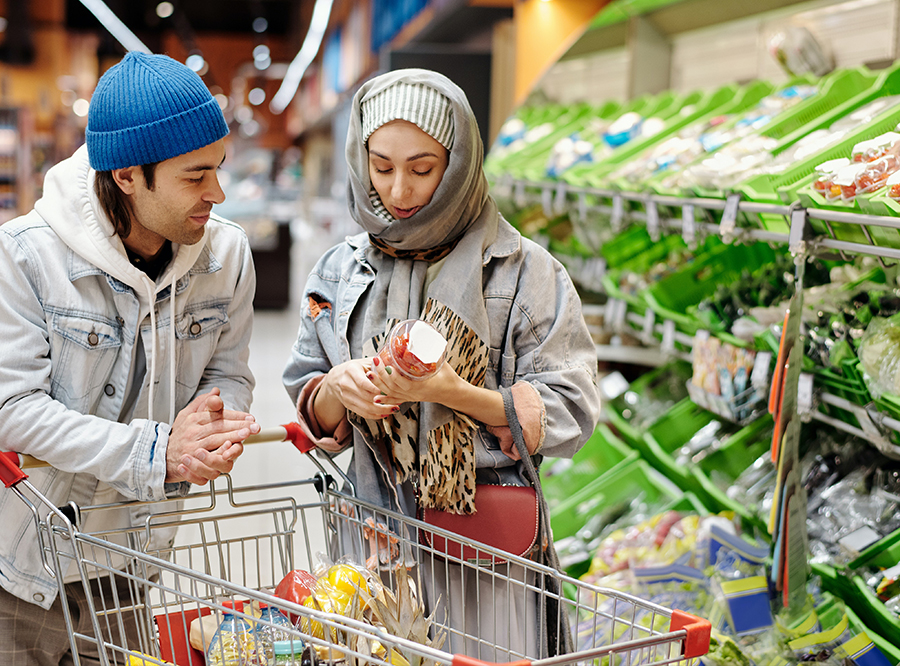Vivid colors for greater clarity

If you want to become more conscientious in your food choices, you can buy your fruit and vegetables according to the season or buy food produced in your local region. So no strawberries in January? Unfortunately, it’s not always that simple. It can often be difficult for consumers to know which food products are especially climate-damaging, but a new climate label could provide some clarity here. Sonnenallee took a closer look.
Let’s start with a sobering statistic: In this country, food accounts for one fifth of an individual’s carbon footprint. This is according to data gathered by the Scientific Advisory Council on Agricultural Policy, Nutrition and Consumer Health Protection. So by shopping more conscientiously, we can all make an important contribution to reducing our carbon footprint.
Consumers are now well aware of the high emissions involved in the production of meat, but only very few people are aware that the carbon footprint of cheese is not much better than that of meat, says Professor Achim Spiller from the University of Göttingen, Germany, who has developed and proposed a new climate label. The situation is even more difficult when it comes to deciding which tomatoes to buy: Do you opt for German tomatoes, which have to be grown over winter in energy-intensive greenhouses? Or do you buy tomatoes from Spain, which mature without additional energy input but have to be transported all the way to Germany? How are you supposed to know which tomato has the better carbon footprint?
A colorful scale similar to Nutri-Score
A standardized climate label could make life easier for consumers. Spiller’s strategy involves calculating average values for product groups and assigning different colors, a system that consumers are already familiar with from Nutri-Score. Green indicates a low carbon footprint, red a very high one. In addition to this color-coding, Spiller’s proposed label would also state the CO2 equivalents.


To begin with, each liter of milk is assigned the same value on the color scale. This allows them to be distinguished from substitute products, says the Professor of Agricultural Economics and Digital Farm Management. Next, the food producers themselves have the opportunity to decide if they can produce their product using more climate-friendly methods or whether they are already doing so (e.g., by using green energy). “They could calculate the climate value of their products individually and use the fact that they are better than the average to promote their products,” says Spiller, who also sees the climate label as a valuable marketing tool.
The ingenious thing about the climate label is that it would not only provide greater transparency for consumers, but also create more awareness in the food industry concerning climate protection. “Companies and consumers have to be clear that now is the time to think about what we can do to protect the climate,” says Spiller. “Simply wanting to put the brakes on the juggernaut cannot be the right strategy.”
New proposal creates new impetus
Achim Spiller is well aware of the challenges in trying to introduce a label like this. “The challenges in promoting the carbon label lie in the endless disputes over its shape and design, in the problems associated with standardizing the calculation methods, in finding the right reference basis for the calculations and, above all, in the relationship between obligation and voluntariness,” he says, “which is why we want to create a decisive impetus with our proposal.”
Nevertheless, he still recommends a binding, state-certified climate label. He recommends that small businesses be initially exempt from the process. “Germany could assume a pioneering role in the EU and promote this comparatively efficient consumer information tool in a sector that is otherwise largely exempt from climate protection measures,” says Spiller. In its proposed form, the climate label is also a relatively cost-effective instrument of climate policy that, in addition to directly influencing consumer habits, could help promote a more objective, fact-based discussion.
A startup makes labeling easier
Past experience, however, has shown just how vulnerable the process of developing food labels is to the influence of lobby groups. But nowadays, companies can commission other companies to calculate the carbon footprint of their products – like the Swiss startup Eaternity. Based on the available food data, the company creates a detailed scientific sustainability metric for a product.
The founders have made it their mission to ensure that every restaurant and every food market can in the future offer a sustainable selection of products. To achieve this, Eaternity is building the next generation of technological solutions and services for the food service sector. “This technological solution could offer a relatively simple way of calculating the average values for the climate label we are proposing,” says Spiller of the University of Göttingen, citing this as proof that the label is practicable and sensible.
As long as the right people want it. Politicians have so far expressed their reservations about yet another food labeling system. For the Federal Ministry of Food and Agriculture, the proposed climate label does not go far enough – they say it addresses only some of the environmental problems. Spiller disputes this: “A climate label looks at the entire value chain. It is indeed true that greenhouse gas emissions constitute just one aspect of environmental pollution, but, in terms of environmental policy, probably the most important one.”
A new climate label may not solve all the problems, but it could be an important first step on the road toward greater consumer transparency and more conscientious consumption.


